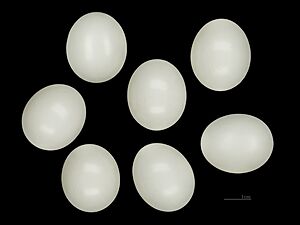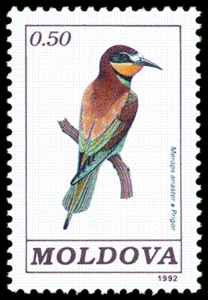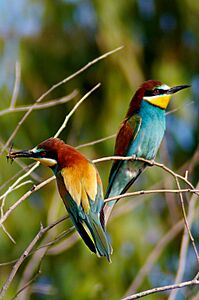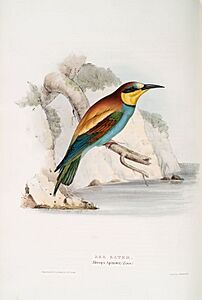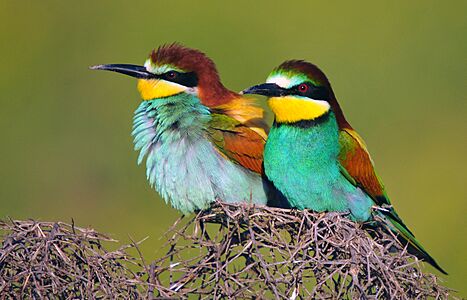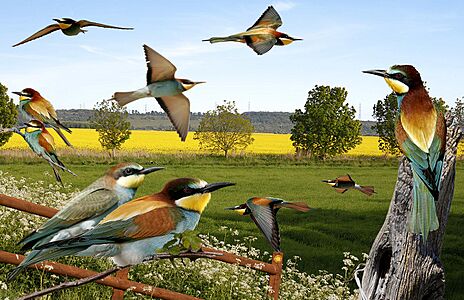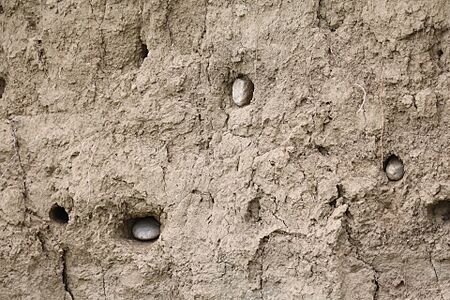European bee-eater facts for kids
Quick facts for kids European bee-eater |
|
|---|---|
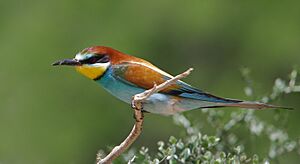 |
|
| Conservation status | |
| Scientific classification | |
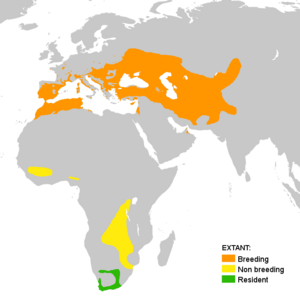 |
|
| Distribution of Merops apiaster |
The European bee-eater (Merops apiaster) is a beautiful, colorful bird that belongs to the bee-eater family. These birds live and breed in many parts of the world, including southern and central Europe, northern and southern Africa, and western Asia. Most European bee-eaters are migratory, meaning they fly long distances to warmer places for winter, usually to tropical Africa. Sometimes, they even show up in northern Europe, where they might occasionally nest.
Contents
About the European Bee-Eater's Name
The European bee-eater was first officially described in 1758 by a Swedish scientist named Carl Linnaeus. He gave it the scientific name Merops apiaster. The name Merops comes from an old Greek word for "bee-eater." The second part, apiaster, is a Latin word that also means "bee-eater," and it comes from the Latin word apis, which means "bee." So, its name literally means "bee-eater bee-eater"!
What Does a European Bee-Eater Look Like?
European bee-eaters are known for their bright colors and slim bodies. They have brown and yellow feathers on their upper parts, while their wings are green. Their beak is black. These birds can grow to be about 27 to 29 centimeters (10.5 to 11.5 inches) long. This length includes their two long tail feathers in the middle.
Both male and female bee-eaters look quite similar. However, females often have more green feathers on their shoulders instead of gold. When they are not breeding, their colors are a bit duller, and their back might look more blue-green. They also lose their long central tail feathers. Young bee-eaters look a lot like non-breeding adults, but their feather colors are less varied. Adult bee-eaters change their feathers (this is called moulting) between June and September. They also moult again in winter when they are in Africa, getting ready for the next breeding season.
Life and Habits of Bee-Eaters
How European Bee-Eaters Reproduce
European bee-eaters are very social birds. They like to nest together in large groups called colonies. They often choose sandy banks, especially near rivers, to dig their nests. They usually start nesting around the beginning of May.
These birds dig long tunnels for their nests. Inside, they lay about five to eight round, white eggs, usually around the beginning of June. Both the male and female bee-eaters take turns sitting on the eggs to keep them warm. This takes about three weeks. They also feed and rest together as a group.
During courtship, the male bee-eater will offer large insects to the female. He eats the smaller ones himself. Most male bee-eaters have one partner, but sometimes a male might have two. Their call is easy to recognize. It sounds like a soft, flowing prreee or prruup.
What Do Bee-Eaters Eat?
These birds live in open areas with warmer weather. As their name suggests, European bee-eaters mainly eat insects. They especially love to eat bees, wasps, and hornets. They are very good at catching insects while flying. They often wait on an open branch and then fly out quickly to grab an insect.
Before eating a bee, a European bee-eater is very clever. It removes the bee's sting by hitting the insect repeatedly on a hard surface. A single bee-eater can eat around 250 bees in one day!
The most important part of their diet is a group of insects called Hymenoptera, which includes many types of bees, especially the European honey bee. One study in Spain found that bees and wasps made up 69% to 82% of what European bee-eaters ate. However, their impact on bee populations is usually very small. They eat less than 1% of the worker bees in the areas where they live.
Scientists have also found that European bee-eaters grow better if they eat a mix of bees and dragonflies. They are healthier than if they only eat bees or only dragonflies.
Bee-Eaters and Honey Bees
Sometimes, if a place where people keep bees (called an apiary) is very close to a bee-eater colony, the birds might eat more honey bees. This is because there are so many bees available. However, studies show that bee-eaters do not usually fly directly into apiaries. Instead, they hunt for insects in fields and meadows up to 12 kilometers (about 7.5 miles) away from their colony. They only fly that far if there isn't enough food closer by.
Observations show that bee-eaters might visit an apiary only when the weather is cold and rainy. During these times, bees do not leave their hives, and other insects are harder for the bee-eaters to find.
Many bee-keepers sometimes worry that bee-eaters stop their worker bees from leaving the hive to find food. They think the bees stay inside for much of the day between May and August because of the birds. However, a study in Libya showed that bee-eaters were not the main reason bees stayed in their hives. In some cases, bees actually went out to find food more often when the birds were around! The study found that the birds' meals were mostly honey bees (about 90.8%) and some beetles (9.2%).
Bee-eaters might eat more bees when new queens are being raised or during the busiest times of bee migration, from late March to mid-April and in mid-September. Beehives that are close to or under trees or power lines are also at a higher risk. This is because the birds can easily perch there and then swoop down on flying insects.
Gallery
-
European bee-eater painted by John Gould, an English ornithologist
See also



